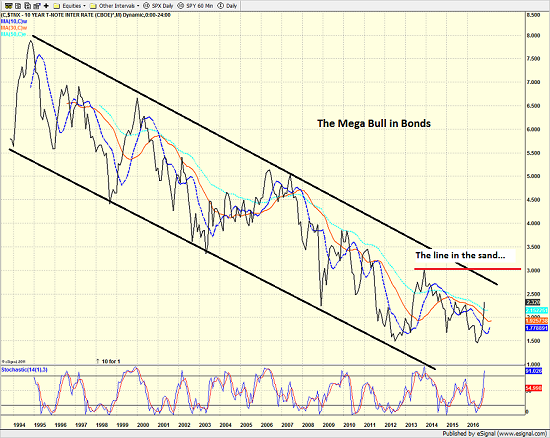Has The “Great Rotation” Finally Begun?
As long-time readers know, I tend to have a glass-is-at-least-half-full view of the markets and the U.S. economy. For example, during the recent sloppy period in stocks, which began in mid-August and ended the day Donald Trump was declared the winner of the Presidential election, my team remained resolute in our view that the bulls deserved the benefit of any/all doubt and that the new cyclical move higher in the stock market had only just begun.
However, this does not mean that there aren’t things to worry about in the markets. And frankly, the thing that has kept me up at night from time to time recently is my concern that we’re seeing a sea change in the bond market – a mega shift that could also change the way Americans view asset allocation and portfolio design.
To be sure, bonds and bond funds have provided investors with a nice base in portfolios for decades. Bonds could be counted on to produce a steady yield year in and year out. And then when things got dicey in the stock market, investors could rest assured that their government bonds and/or bond funds would help cushion the blow.
Even during more recent times, when correlations among asset classes have tended to move to 1.0 during times of “crises” (or perceived crises), government bonds were the one thing in a portfolio that investors could count on to NOT act like the stock market. Cutting to the chase, my concern is that this may be changing.
Below is a chart of the yield of the U.S. 10-Year Treasury. Note that this chart has been moving from the upper left to the lower right for years, even decades. And since bond prices act inversely to yields, this means that prices of bonds have been steadily rising for a very long time.
(Click on image to enlarge)

The question of the day though is if the bull market in bonds, a move that has been largely intact since the early 1980’s is about to morph into a secular bear market.
To clarify, we continue to believe that government bonds will be the place to be when things get ugly in the stock market. However, save the periods of crisis, the concern is that bonds could begin to move steadily lower – or worse over the coming years.
Unfortunately, I’m not alone in this view. Recently both Blackrock and JPMorgan have issued reports expressing similar views. The fear is that we may be seeing some cracks in that steady base that advisors have built client portfolios on for decades.
This week, influential manager, Bob Doll said that the 35-year tailwind for bond investors is now turning into a headwind. Doll encouraged investors to trim bond holdings into rallies and move the money into stocks during declines.
In other words, the long-awaited “great rotation,” something that has been talked about for five years, could actually now be starting.
Tomorrow, we’ll take a look at the reasons why I think this shift could (key word) be taking place.
Current Market Drivers
We strive to identify the driving forces behind the market action on a daily basis. The thinking is that if we can both identify and understand why stocks are doing what they are doing on a short-term basis; we are not likely to be surprised/blind-sided by a big move. Listed below are what we believe to be the driving forces of the current market (Listed in order of importance).
1. The State of the “Trump Trade”
2. The State of Global Central Bank Policies
3. The State of Interest Rates
4. The State of Global Economies
Thought For The Day:
Let him that would move the world first move himself. -Socrates
Comments
 No Thumbs up yet!
No Thumbs up yet!



